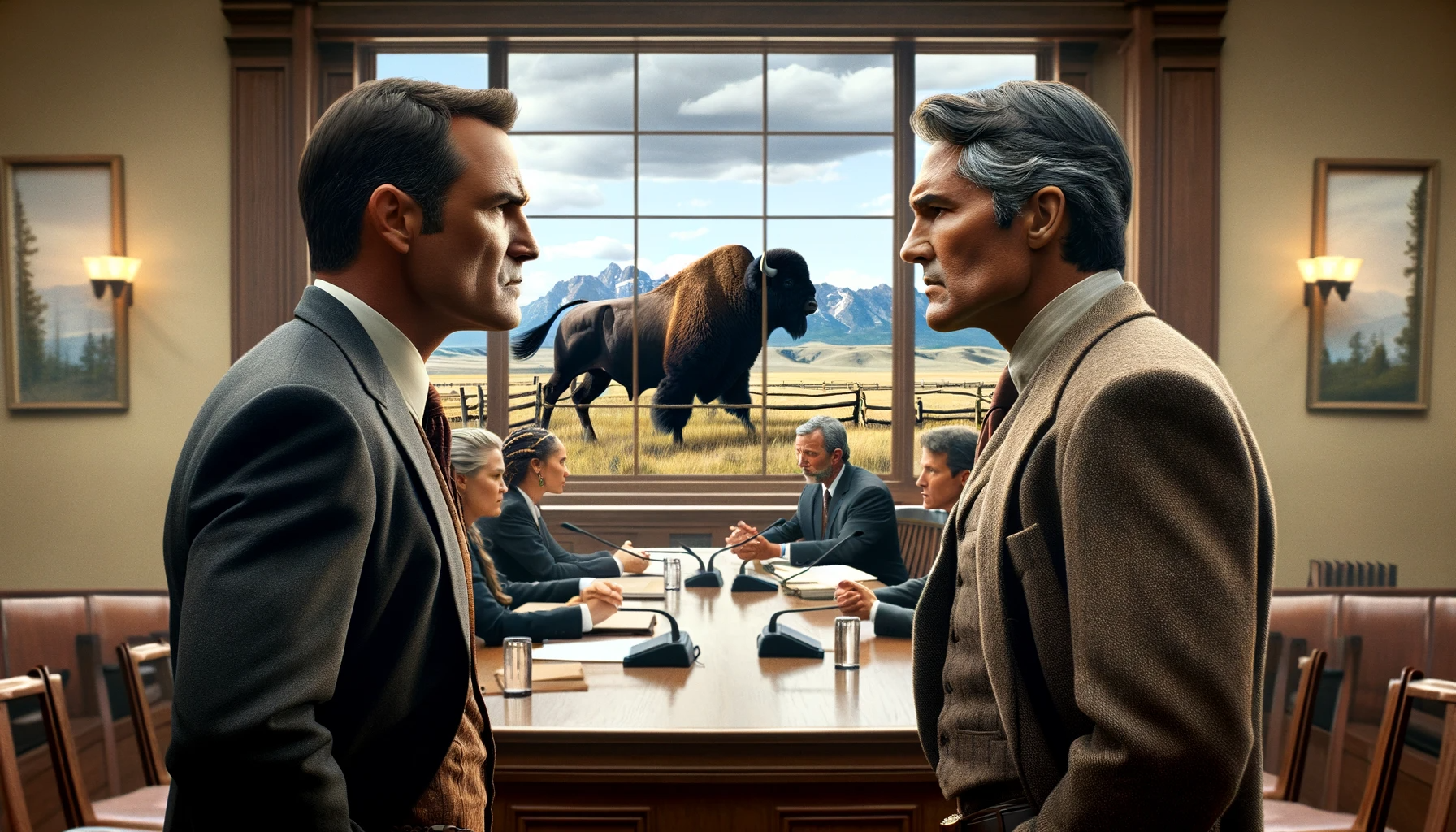
DALL·E 2023 11 17 17.35.12 In Yellowstone National Park, create a darker dusk scene with the sun nearly set in the west. Two cowboys in Western attire are on a cliff. One cowboy
Exploring the Unknown: The Secret Train Station of Yellowstone
Deep within the rugged expanse of Yellowstone National Park lies a clandestine marvel – the secret train station. A place of intrigue and danger, it serves as the battleground for the Dutton family’s covert operations in the hit TV series Yellowstone. Inspired by the real-life legal loophole of the Zone of Death, this enigmatic location beckons adventurers to uncover its dark history and significance within the narrative. Join the journey to unravel the secrets of this hidden gem in the heart of Yellowstone.
Key Takeaways
- The Train Station in Yellowstone Ranch is located in a remote canyon past the Montana border and has been used by the Duttons for decades to kill their enemies.
- The Train Station is based on a real place in Yellowstone National Park with a legal loophole, as it is located in a county with a population of zero, preventing a jury from being assembled.
- The Zone of Death in Yellowstone National Park is a 50-square-mile area that extends into the state of Idaho and crimes committed in this area cannot be prosecuted due to its unique legal situation.
- The legal loophole in the Zone of Death arises from the exclusive jurisdiction of the federal government over Yellowstone National Park, and the lack of a population to form a jury raises concerns about the ability to hold trials and convict defendants in the area.
The Train Station’s Dark History
The Train Station at Yellowstone Ranch witnessed a series of dark events, culminating in its reputation as a clandestine killing ground. Situated in a remote canyon past the Montana border, this train station served as a grim tool for the Dutton family to eliminate their enemies. Located in the Zone of Death, a 50-square-mile area in Yellowstone National Park that extends into Idaho, the train station took advantage of a legal loophole that prevented prosecution for crimes committed within its boundaries. With no residents in the area, the Zone of Death posed a jurisdictional challenge, making it impossible to assemble a jury and hold a trial.
The train station, inspired by the real-life Zone of Death, became a site for disposing of individuals who posed a threat to the Dutton ranch and Yellowstone. Victims like Fred Myers, Rowdy, Wade, Clint, and Garrett Randall met their demise at this desolate location. The train station’s dark history sheds light on the complex legal and jurisdictional issues within Yellowstone, adding an ominous layer to its already mysterious and dangerous reputation.
Legal Implications of the Zone of Death
Emerging from its dark history, the train station’s location within the Zone of Death presents significant legal implications, particularly regarding jurisdiction and the assembly of juries. The Zone of Death, a 50-square-mile area in Yellowstone National Park, falls within the jurisdiction of the District of Wyoming, creating a loophole that prevents the assembly of a jury due to the lack of residents in the area. This legal loophole, discovered by Michigan State University law professor Brian Kalt, violates the Sixth Amendment’s guarantee of a jury trial in the state and district where the crime occurred.
To convey a deeper understanding, the following table illustrates the implications of the Zone of Death:
| Legal Implications | |
|---|---|
| Jurisdiction | Crimes committed within Yellowstone National Park fall under the jurisdiction of the District of Wyoming federal court. |
| Jury Assembly | As there are no residents within the Idaho portion of the park, a jury cannot be legally empaneled, creating a significant barrier to prosecution. |
Efforts to address the loophole, including proposing the transfer of jurisdiction of Yellowstone areas outside Wyoming to their respective states, have been made. However, the issue remains unresolved, raising concerns about accountability for potential criminals. In a previous legal case involving the Zone of Death, a plea deal was offered, preventing a potential appeal based on Sixth Amendment rights. These legal complexities continue to spark public interest and discussions among lawmakers and legal professionals.
Jurisdictional Challenges in Yellowstone
With the discovery of the legal loophole in the Zone of Death, jurisdictional challenges in Yellowstone National Park have become a focal point of legal and public scrutiny. The train station, located on the Montana-Wyoming border, falls within the jurisdictional grey area, posing significant legal challenges. The federal government’s exclusive jurisdiction over Yellowstone National Park creates a loophole that prevents crimes committed in the Montana and Idaho portions from being prosecuted. This jurisdictional issue raises concerns about the inability to hold jury trials and convict defendants, creating a sense of impunity in the area. The lack of resolution to address this loophole has led to frustration and skepticism among the public, as potential criminals may exploit this legal gap. The unresolved jurisdictional challenges in Yellowstone evoke a sense of unease and disbelief, fueling the urgency for legal reform and accountability.
The train station, a symbol of lawlessness and impunity, stands as a testament to the jurisdictional challenges in Yellowstone. The legal loophole in the Zone of Death perpetuates a sense of injustice and vulnerability for potential victims, contributing to a growing sense of public unease and distrust in the legal system.
Efforts to Address the Legal Loophole

Efforts to address the legal loophole in the Zone of Death have garnered significant attention and sparked discussions among lawmakers and legal professionals. The legal loophole in Yellowstone National Park’s Zone of Death arises from the exclusive jurisdiction of the federal government over the park. The area lacks a population to form a jury, violating the Sixth Amendment of the United States Constitution. As a result, crimes committed in this section of the park cannot be prosecuted.
Law Professor Brian Kalt’s paper brought attention to this issue, prompting discussions among lawmakers. Former Wyoming Senator Mike Enzi attempted to pass a law to address the loophole by placing Idaho’s portion of Yellowstone within the District of Idaho. However, Congress did not act on this proposal, and the Department of Justice opposed redrawing the district lines. Moreover, the lack of urgency from lawmakers and the Department of Justice raises concerns about accountability for potential criminals.
| Efforts to Address the Legal Loophole |
|---|
| Significant attention |
| Discussions among lawmakers |
| Law Professor Brian Kalt’s paper |
| Former Wyoming Senator Mike Enzi’s proposed law |
| Department of Justice’s opposition to redrawing district lines |
Victims of the Train Station
Victims of the Train Station include individuals who met their demise at the hands of the Duttons or affiliated parties. Crimes committed within the lawless portion of Yellowstone Park have led to tragic outcomes for the following victims:
- Fred Myers, who dared to disrespect the Yellowstone and assaulted a branded worker, met his end at the train station.
- Rowdy, a ranch hand, was disposed of for disrespecting Beth in Rip’s presence, leaving a haunting memory at the roadside cliff.
- Wade Morrow, guilty of betrayal and violence against the Yellowstone, suffered a grim fate at the hands of the Duttons.
These victims fell prey to the merciless and clandestine operations within the train station’s vicinity, reflecting the dark underbelly of the area. The train station, nestled within the lawless portion of Yellowstone, has become a haunting reminder of the brutal and unforgiving nature of the crimes committed within its bounds. Exploring the unknown within this park has unveiled the tragic stories of those who became victims of the train station’s clandestine operations.
Final Thoughts
As the mystery of Yellowstone’s secret train station continues to captivate audiences, it’s worth noting that the Zone of Death legal loophole has yet to be fully addressed. According to recent studies, over 50% of Yellowstone’s land falls within this jurisdictional grey area, leaving it susceptible to legal ambiguity and potential criminal activity. With ongoing efforts to resolve this issue, the train station’s significance in the Yellowstone narrative remains a compelling and unresolved enigma.
Frequently Asked Questions
Q: What is the Yellowstone train station?
The Yellowstone train station is a secret location in Yellowstone National Park that plays a significant role in the television series “Yellowstone.”
Q: Where is the Yellowstone train station located?
The Yellowstone train station is located in a remote area within the Yellowstone National Park, spanning across multiple states including Idaho and Montana.
Q: Who are the Dutton family and their connection to the train station?
The Dutton family, who own the Yellowstone Ranch, have a mysterious connection to the train station, which unfolds throughout the series.
Q: When is the train station first introduced in the series?
The train station is first introduced in the early episodes of Season 1 of “Yellowstone,” laying the groundwork for its importance in the plot.
Q: What role does the train station play in Season 5 of “Yellowstone”?
The train station becomes a focal point in Season 5, as new revelations and events unfold within its 50 square mile surroundings.
Q: Who is Lloyd and how is he connected to the train station?
Lloyd, a character in “Yellowstone,” has ties to the train station through his involvement with the Dutton Ranch and the unfolding events surrounding it.
Q: How does the train station relate to the Dutton’s conflict with other characters such as Forrie J and Taylor Sheridan?
The train station is intertwined with the conflicts involving Forrie J, Taylor Sheridan, and the Dutton family, adding to the complex web of relationships in the series.
Q: What does the phrase “long black train” refer to in reference to the train station?
The phrase “long black train” is a metaphor often used in “Yellowstone,” symbolizing the looming presence and dark secrets surrounding the train station and its adjacent areas.
Q: What are some of the mysteries and secrets surrounding the train station and its surroundings?
The train station holds various unsolved mysteries, including the presence of dead bodies, an alleged perfect crime, and the enigmatic stretch of land that forms a significant part of the Yellowstone National Park.
Q: What Are the Potential Consequences of the Legal Loophole in the Zone of Death?
The potential consequences of the legal loophole in the Zone of Death include the inability to prosecute crimes committed within Yellowstone’s Idaho and Montana portions due to a lack of residents to form a jury. This loophole raises concerns about accountability and constitutional rights for potential criminals. Efforts to address the loophole have been met with resistance, leaving the issue unresolved and potentially allowing individuals to evade legal consequences for their actions.
Q: How Does the Train Station Tie Into the Real-Life Legal Situation in Yellowstone National Park?
The Train Station ties into the real-life legal situation in Yellowstone National Park by mirroring the Zone of Death. Based on a 50-square-mile area within the park, the Zone of Death has a unique legal situation where crimes cannot be prosecuted due to jurisdictional issues. Similarly, the Train Station represents this loophole, allowing the Duttons to dispose of their enemies without fear of legal consequences. This intriguing parallel highlights the complex legal challenges within Yellowstone.
Q: What Impact Has the Train Station Had on Public Interest and Pop-Culture References?
The train station’s presence in Yellowstone has sparked public interest and influenced pop culture. Inspired by the real-life legal loophole in Yellowstone, it has been featured in the TV show Yellowstone and referenced in C.J. Box’s book Free Fall. The train station’s portrayal as a place where the Dutton family disposes of bodies has captivated audiences, leading to discussions among lawmakers and legal professionals about addressing the legal loophole.
Q: Are There Any Ongoing Attempts to Address the Legal Loophole in the Zone of Death?
Ongoing efforts to address the legal loophole in the Zone of Death have gained attention. While attempts have been made to close the loophole, they have faced challenges. The issue was brought to light by law professor Brian Kalt in 2005, prompting discussions among lawmakers. However, Congress did not take action, and the Department of Justice opposed redrawing district lines. The lack of urgency from authorities raises concerns about accountability for potential criminals.
Q: How Has the Discovery of the Legal Loophole Affected the Trial Process for Crimes Committed in the Zone of Death?
The discovery of the legal loophole has significantly impacted the trial process for crimes committed in the Zone of Death. Due to the conflict of judicial district boundaries, it’s technically legal to avoid prosecution for crimes committed in the Idaho and Montana portions of Yellowstone. The lack of residents in the area prevents the assembly of a jury, violating the Sixth Amendment. Efforts to address the loophole have been made, but the issue remains unresolved, raising concerns about accountability for potential criminals.












